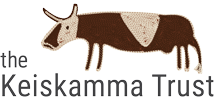A response to the Keiskamma Covid Resilience Tapestry
by Marguerite Poland, 2020
The pasture was rich between thickets of bush, cattle thrived: the land of the Ndlambe Xhosa.
If the winters were cold and dry, the spring was heralded by the arrival of the red-chested cuckoo calling, ‘Phezukomkhono’ – ‘hoe to the shoulder’ – the time for planting. In early summer when rain was frequent, the inkanku-bird predicted abundant milk and umvemve, the wagtail, guarded the new-born calves. The rains and sunshine ensured a yield of maize, pumpkins and sorghum and people eagerly awaited ukuShwama, to celebrate the First Fruits Ceremony, after which the gardens could be harvested: ‘Be cheerful, the pumpkins are ripe!’
There were not only times of plenty. There were also times of drought, flood, disease and death. These, too, were anticipated. Communities lived with the accepted cycle of the seasons, moved back and forth within ancestral lands in search of better grazing, surer water, richer soil. At the heart of the culture were the cattle: the economic and spiritual centre of well-being.
And then the colonists came.
In 1809, despite a claim that he had paid 800 head of cattle to retain his people’s right to their traditional grazing – the horn shapes of which he could enumerate as evidence – Ndlambe and his people were forced to retreat east of the Great Fish River which was summarily declared the border between ‘colonial’ and ‘indigenous’ lands. It was while in retreat that 23,000 cattle of the Ndlambe were captured by the military in the dense bush flanking the Keiskamma River at the mouth of which the hamlet of Hamburg now stands. Without their cattle the people believed they had been ‘left to perish’.
In 1854 a bull, imported from Europe, brought with it an unknown and highly-infectious disease: lung-sickness. It spread rapidly throughout the country. Cattle died in their thousands. Among the most significant reactions to this event and to the ongoing conflict in contested territory, was a millenarian response which led to the Cattle Killing tragedy of 1856-1858 which decimated not only the cattle of the Xhosa but the people themselves. Those events have been preserved by the artists of Hamburg – among them, descendants of the tragedy – in the monumental tapestry depicting Xhosa history which hangs in the South African Parliament today.
And now, in 2020, catastrophe has struck again.
This time an insidious and undiscriminating plunderer has swept the entire world: Covid19. The response of the artists of the Keiskamma Art Project has been to record, once again, in images and words drawn from their lore, cultural heritage and landscape, a response to a scourge which so profoundly affects their lives. Like many of the Keiskamma Art Project’s previous works, all of which have been powerful representations of significant events, the creation of this tapestry will be symbolic of this catastrophic pandemic.
To imagine, to create, to record, especially in moments of uncertainty and fear, is an act of faith, not defeat. And the hope of regeneration is represented in the tapestry by the outstretched branches of the ancient umkhiwane fig tree of Hamburg, witness with varied creatures through many seasons over countless years, to the lives of generations of people who have sheltered in its shade.

